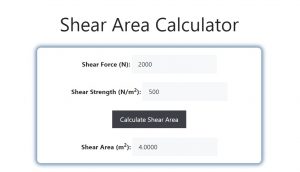About Shear Area Calculator (Formula)
The Shear Area Calculator is a powerful tool used to determine the shear area in various structural and mechanical applications. By understanding the forces at play and utilizing simple formulas, this tool makes it easy to calculate shear area and ensure safe, reliable designs. Whether you’re an engineer or a student, this calculator can streamline your workflow and improve accuracy.
Formula
The formula used to calculate the shear area is as follows:
Shear Area (SHA) = Shear Force (SF) / Shear Strength (SS)
Where:
- Shear Area (SHA) is the area where the shear force acts.
- Shear Force (SF) is the force causing the material to fail due to shear.
- Shear Strength (SS) is the material’s capacity to resist the shear force.
How to Use
To use the Shear Area Calculator:
- Input the value of the shear force (SF) acting on the material.
- Enter the material’s shear strength (SS), typically obtained from material specifications.
- Click “Calculate” to determine the shear area (SHA).
This tool simplifies the calculation by instantly providing the required shear area once you input the necessary values.
Example
Let’s say you are working with a steel plate where the shear force (SF) is 2000 N and the shear strength (SS) is 400 N/mm². Using the formula:
Shear Area (SHA) = 2000 N / 400 N/mm²
SHA = 5 mm²
In this case, the required shear area is 5 mm² to withstand the applied shear force.

FAQs
- What is a shear area?
The shear area is the surface area of a material that resists shear forces, which can cause the material to slide or fracture. - How is shear force calculated?
Shear force is typically determined based on the load applied to the material and its geometry. It represents the internal force that resists deformation. - What is shear strength?
Shear strength is the maximum amount of shear stress a material can withstand before it fails. It’s a key property used to assess material safety and durability. - Can I use the Shear Area Calculator for any material?
Yes, as long as you know the shear strength of the material, you can use this calculator for various types of materials like steel, aluminum, or plastics. - Where can I find the shear strength of a material?
Shear strength values are typically found in material property databases, engineering handbooks, or manufacturer specifications. - Why is calculating shear area important?
Determining the shear area is crucial in structural and mechanical design to ensure materials can safely handle applied forces without failing. - What units should I use in the Shear Area Calculator?
Ensure that the units of shear force and shear strength are compatible (e.g., Newtons for force and N/mm² for strength). The result will be in the corresponding area units, such as mm². - What happens if the shear area is too small?
If the shear area is too small, the material may not be able to withstand the shear force, leading to structural failure or fracture. - Is shear area the same as shear stress?
No, shear area refers to the physical area where the force acts, while shear stress is the force per unit area acting parallel to the material’s surface. - Can the calculator be used for complex shapes?
Yes, but you will need to calculate or estimate the shear force and shear strength for those shapes using appropriate methods. - What is the difference between shear force and bending force?
Shear force acts parallel to the surface, causing layers to slide over each other, while bending force causes the material to deform in a curve. - How do I ensure my calculation is accurate?
Ensure all values entered (shear force and shear strength) are correct and use consistent units for precise results. - Can this calculator be used for dynamic loads?
The calculator is typically used for static shear force calculations. For dynamic loads, additional factors such as impact and fatigue should be considered. - What industries use shear area calculations?
Industries like construction, automotive, aerospace, and manufacturing frequently use shear area calculations to design safe structures and components. - What if my material fails the shear area test?
If your material doesn’t meet the required shear area, consider increasing the thickness or switching to a stronger material to handle the load.
Conclusion
The Shear Area Calculator simplifies the process of calculating the shear area, making it easy for engineers, designers, and students to assess structural safety. By inputting simple values for shear force and shear strength, this tool delivers quick and reliable results, ensuring your materials are up to the task.